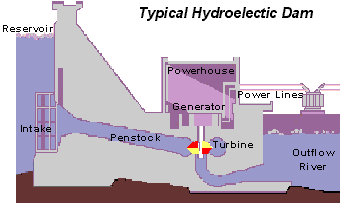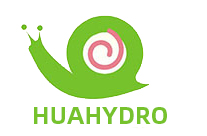Hydropower plant are actually based on a rather simple concept — water flowing through a dam turns a turbine, which turns a generator.
A hydraulic turbine converts the energy of flowing water into mechanical energy. A hydroelectric generator converts this mechanical energy into electricity.

The theory is to build a dam on a large river that has a large drop in elevation. The dam stores lots of water behind it in the reservoir. The water in the reservoir is considered stored energy. Near the bottom of the dam wall there is the water intake. When the gates open, Gravity causes water to fall through the penstock inside the dam. At the end of the penstock there is a turbine propeller, which is turned by the moving water. The shaft from the turbine goes up into the generator, which produces the power.

So just how do we get electricity from water? Actually, hydroelectric and coal-fired power plants produce electricity in a similar way. In both cases a power source is used to turn a propeller-like piece called a turbine, which then turns a metal shaft in an electric generator, which is the motor that produces electricity. A coal-fired power plant uses steam to turn the turbine blades; whereas a hydroelectric plant uses falling water to turn the turbine.
Here are the basic components of a conventional hydropower plant:
Dam – Most hydropower plants rely on a dam that holds back water, creating a large reservoir. Often, this reservoir is

used as a recreational lake.
Intake – Gates on the dam open and gravity pulls the water through the penstock, a pipeline that leads to the turbine. Water builds up pressure as it flows through this pipe.
Turbine – The water strikes and turns the large blades of a turbine, which is attached to a generator above it by way of a shaft.
Generators – As the turbine blades turn, so do a series of magnets inside the generator. Giant magnets rotate past copper coils, producing alternating current (AC) by moving electrons.
Transformer – The transformer inside the powerhouse takes the AC and converts it to higher-voltage current.
Power lines – Out of every power plant come four wires: the three phases of power being produced simultaneously plus a neutral or ground common to all three.
Outflow – Used water is carried through pipelines, called tail races, and re-enters the river downstream.




Leave a comment